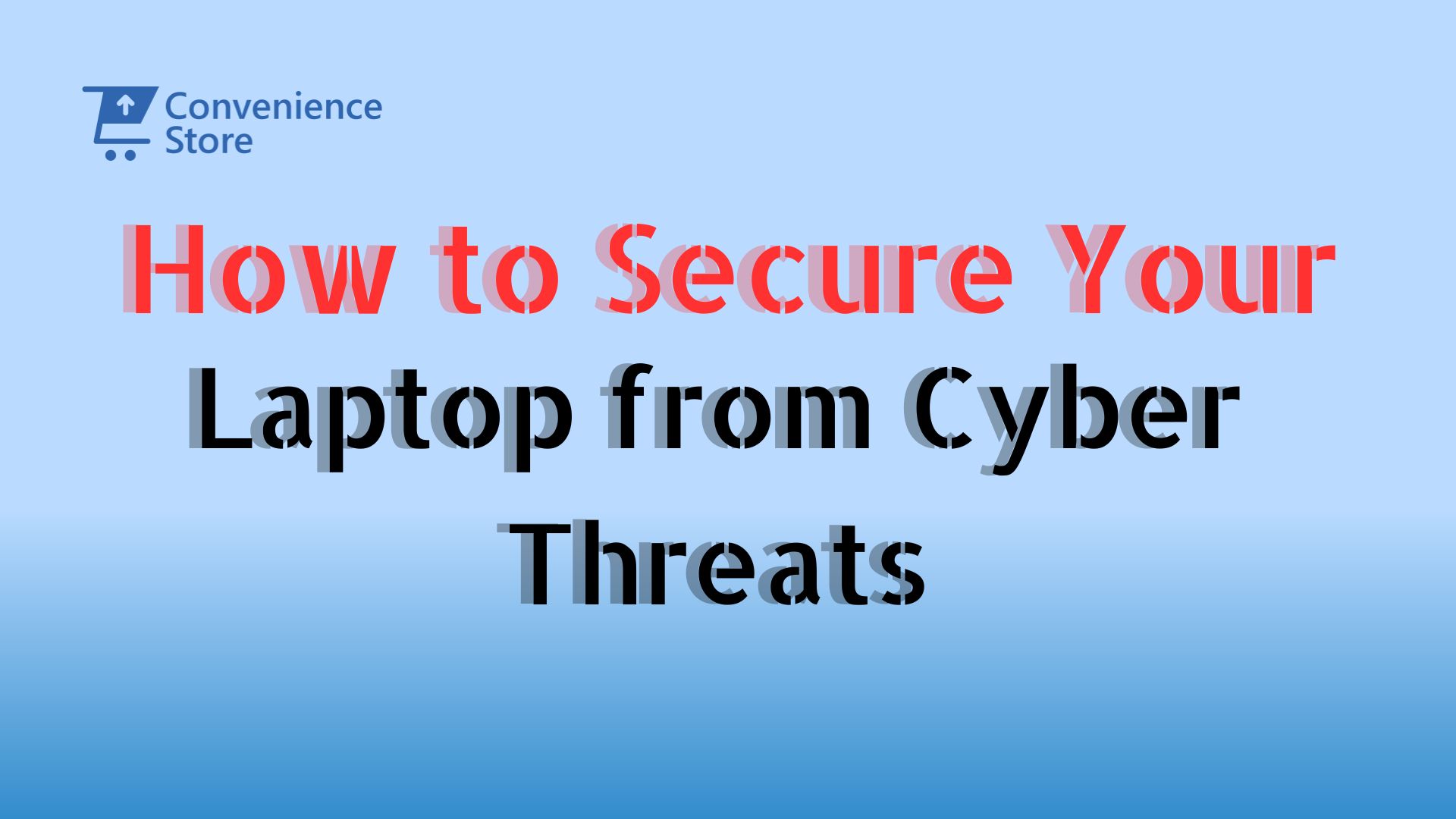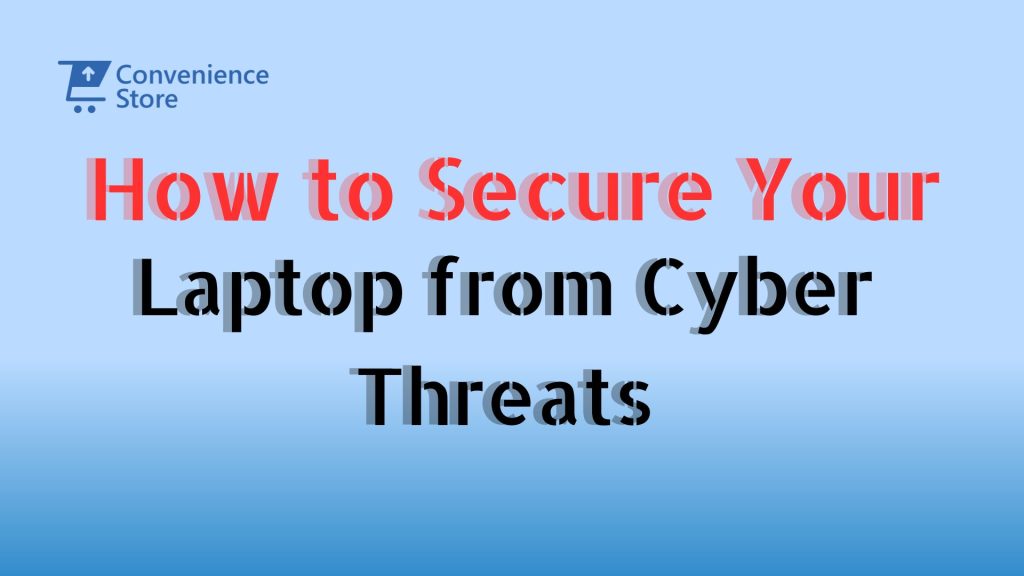How to Secure Your Laptop from Cyber Threats


In today’s digital age, our laptops are not just tools for work and communication; they are vaults of personal and sensitive information. From banking details and personal photographs to confidential work documents, our laptops hold data that, if compromised, can lead to significant financial and emotional distress. Cyber threats are ever-evolving, becoming more sophisticated and harder to detect. Whether you’re a casual user or a business professional, understanding and implementing robust security measures is crucial to safeguard your information.
This comprehensive guide you through essential practices and tools to secure your laptop from various cyber threats. By following these steps, you can significantly reduce the risk of falling victim to cyber-attacks and ensure that your data remains safe and secure.
1. Use Strong, Unique Passwords
Importance of Complex Passwords
Complex passwords are a critical defense against cyber threats. Simple passwords are easy to guess, making your accounts vulnerable to attacks. A strong password should be at least 12 characters long and include a mix of uppercase and lowercase letters, numbers, and special characters. Avoid using easily guessable information like your name, birthdate, or common words.
Use of Password Managers
Remembering multiple complex passwords can be daunting. Password managers like LastPass, 1Password, and Dashlane can help. These tools store and manage your passwords securely, allowing you to use strong, unique passwords for each account without the need to remember them all. Additionally, many password managers can generate random passwords, enhancing your security further.
2. Enable Two-Factor Authentication
What is Two-Factor Authentication?
Two-factor authentication (2FA) adds an extra layer of security to your accounts by requiring two forms of verification. Typically, this involves something you know (your password) and something you have (a code sent to your phone or an authentication app).
How to Set Up Two-Factor Authentication
Setting up 2FA is straightforward. Most online services provide options to enable it in the security settings. Choose the method you prefer, such as receiving codes via SMS or using an authentication app like Google Authenticator or Authy. Follow the on-screen instructions to complete the setup.
3. Keep Your Operating System and Software Updated
Importance of Regular Updates
Cybercriminals frequently exploit vulnerabilities in outdated software. Regular updates patch these vulnerabilities, making it harder for attackers to gain access. Always keep your operating system and all installed software up to date.
How to Set Up Automatic Updates
To ensure your software is always up to date, enable automatic updates. For Windows, go to Settings > Update & Security > Windows Update, and turn on automatic updates. For macOS, go to System Preferences > Software Update and select “Automatically keep my Mac up to date.”
4. Install Reliable Antivirus Software
Choosing the Right Antivirus Software
Antivirus software provides real-time protection against malware, ransomware, and other cyber threats. Choose a reputable antivirus solution like Bitdefender, Norton, or Kaspersky. Look for features like real-time scanning, automatic updates, and comprehensive malware protection.
Regular Scans and Real-Time Protection
Schedule regular scans to check for any malware that may have slipped through. Most antivirus programs allow you to set up automated scans. Ensure that real-time protection is always enabled to monitor and block threats as they occur.
5. Use a VPN for Secure Browsing
Benefits of Using a VPN
A Virtual Private Network (VPN) encrypts your internet connection, protecting your online activities from eavesdroppers. This is especially important when using public Wi-Fi networks, which are often unsecured and susceptible to cyber attacks.
Recommended VPN Services
Consider using reputable VPN services like ExpressVPN, NordVPN, or CyberGhost. These services offer strong encryption, a large number of servers, and a no-logs policy, ensuring your privacy is maintained.
6. Enable Firewall Protection
What is a Firewall?
A firewall acts as a barrier between your computer and the internet, blocking unauthorized access while allowing legitimate communication. It can prevent hackers from accessing your system and spreading malware.
Configuring and Maintaining Your Firewall
Most operating systems come with a built-in firewall. Ensure it is enabled and properly configured. For Windows, go to Control Panel > System and Security > Windows Defender Firewall. For macOS, go to System Preferences > Security & Privacy > Firewall. Keep your firewall rules updated to block any suspicious activities.
7. Secure Your Home Network
Setting Up a Secure Wi-Fi Network
Securing your home network is essential to prevent unauthorized access. Use a strong password for your Wi-Fi network and change the default network name (SSID) to something unique.
Changing Default Router Settings and Passwords
Access your router’s settings by entering its IP address into your web browser. Change the default admin username and password to something more secure. Enable WPA3 encryption if available, or at least WPA2, to protect your network traffic.
8. Be Cautious with Email and Attachments
Identifying Phishing Emails
Phishing emails are designed to trick you into revealing personal information. Look out for emails from unknown senders, with urgent language, or asking for sensitive information. Verify the sender’s email address and avoid clicking on suspicious links or attachments.
Safe Practices for Handling Attachments
Never open attachments from unknown or untrusted sources. Even if an email appears to come from a known contact, verify with them before opening any unexpected attachments. Use antivirus software to scan attachments for malware.
9. Regularly Backup Your Data
Methods of Data Backup
Regularly backing up your data ensures you can recover your files in case of a cyber attack, hardware failure, or other data loss incidents. Use multiple backup methods such as external hard drives, cloud storage services like Google Drive, Dropbox, or OneDrive, and network-attached storage (NAS) devices.
Importance of Keeping Backups in Secure Locations
Store backups in secure locations to protect them from physical theft or damage. Encrypt sensitive data before backing it up to add an extra layer of security. Regularly test your backups to ensure they can be restored successfully.
10. Disable Unnecessary Services and Ports
Identifying and Disabling Unused Services
Unnecessary services and open ports can be exploited by attackers. Review the list of services running on your laptop and disable any that are not needed. For Windows, use the Services app; for macOS, use the Activity Monitor.
Managing Open Ports on Your Laptop
Use a port scanning tool to identify open ports on your laptop. Close any ports that are not needed for your regular activities. For Windows, use the Command Prompt with the netstat command; for macOS, use the Network Utility.
11. Use Disk Encryption
Benefits of Encrypting Your Hard Drive
Disk encryption protects your data by converting it into unreadable code that cannot be deciphered easily. This is crucial if your laptop is lost or stolen, as it prevents unauthorized access to your files.
How to Enable Encryption on Different Operating Systems
For Windows, use BitLocker by going to Control Panel > System and Security > BitLocker Drive Encryption. For macOS, enable FileVault by going to System Preferences > Security & Privacy > FileVault. Follow the on-screen instructions to complete the encryption process.
12. Be Wary of Public Wi-Fi Networks
Risks of Using Public Wi-Fi
Public Wi-Fi networks are often unsecured, making them a prime target for cybercriminals. They can intercept your data, steal login credentials, or inject malware into your device.
Best Practices for Staying Safe on Public Networks
Avoid accessing sensitive information, such as online banking or shopping, over public Wi-Fi. Use a VPN to encrypt your connection and enhance your privacy. Disable automatic Wi-Fi connections on your laptop to prevent it from joining unsecured networks automatically.
13. Secure Your Physical Device
Using Physical Locks
A physical lock, such as a Kensington lock, can prevent theft by securing your laptop to a fixed object. This is particularly useful in public places or shared environments.
Setting Up Device Tracking and Remote Wipe Features
Enable device tracking features like Find My Device for Windows or Find My Mac for macOS. These tools allow you to locate your laptop if it’s lost or stolen and remotely wipe your data if recovery is not possible.
14. Educate Yourself on Social Engineering Attacks
Understanding Social Engineering
Social engineering attacks manipulate individuals into divulging confidential information. Common tactics include phishing emails, pretexting, and baiting.
Tips to Avoid Falling Victim to These Attacks
Be cautious with unsolicited communications asking for personal information. Verify the identity of the requester through independent means before sharing any data. Stay informed about common social engineering tactics and how to recognize them.
15. Monitor Your Accounts and Activities
Keeping an Eye on Login Attempts and Unusual Activities
Regularly review your account activity for any unauthorized access or suspicious behavior. Most online services provide activity logs where you can check recent login attempts and other account activities.
Using Security Alerts and Notifications
Enable security alerts and notifications for your accounts. These alerts can notify you of unusual login attempts, password changes, or other security-related events. Promptly investigate and address any alerts to maintain your account security.
Securing your HP laptop in Kenya from cyber threats is not a one-time task but an ongoing commitment to staying informed and vigilant. By implementing the strategies outlined in this guide—using strong, unique passwords, enabling two-factor authentication, keeping your software updated, installing reliable antivirus software, and more—you can significantly reduce your risk of falling victim to cyberattacks. Remember, the key to effective cybersecurity is a proactive approach. Regularly review and update your security measures to keep pace with evolving threats and ensure your personal and professional data remains protected.
Securing your HP laptop in Kenya from cyber threats is an ongoing process that requires vigilance and proactive measures. By implementing the practices and tools discussed in this blog, you can create a robust defense against potential attacks. From strong passwords and regular software updates to encryption and antivirus programs, each step plays a critical role in protecting your sensitive data.
Remember, cyber threats are constantly evolving, so staying informed about the latest security trends and threats is essential. Regularly review and update your security practices to address new vulnerabilities and ensure your information remains protected.
By taking these steps, you not only safeguard your personal and professional data but also contribute to a safer digital environment for everyone. Stay secure, stay informed, and make cyber security a priority in your daily digital activities.
FAQ
Q1: How often should I update my passwords?
A: It’s recommended to update your passwords every three to six months. Additionally, update them immediately if you suspect any of your accounts have been compromised.
Q2: What should I do if I receive a suspicious email?
A: Do not click on any links or attachments in the email. Verify the sender’s identity by contacting them directly through a known, trusted method. If you can’t verify the sender, delete the email.
Q3: How can I tell if my laptop has been infected with malware?
A: Common signs of malware infection include slow performance, unexpected pop-ups, programs starting or closing automatically, and unusual network activity. Running a full antivirus scan can help identify and remove malware.
Q4: Is it safe to use free antivirus software?
A: While some free antivirus programs offer basic protection, they may lack advanced features and support. For comprehensive protection, consider investing in a reputable paid antivirus solution.
Q5: Can using a VPN slow down my internet connection?
A: Yes, using a VPN can sometimes slow down your internet connection due to the encryption process. However, the speed impact is usually minimal with high-quality VPN services.
Q6: How do I know if a website is secure?
A: Look for “https://” at the beginning of the URL and a padlock icon in the browser’s address bar. These indicate that the website uses encryption to protect your data.
Q7: What should I do if my laptop is lost or stolen?
A: Use device tracking features to locate your laptop. If you can’t recover it, use remote wipe capabilities to erase your data. Report the loss to the local authorities and change passwords for your accounts.
Q8: How can I secure my laptop when traveling?
A: Use a physical lock to secure your laptop in your hotel room or any shared space. Avoid using public Wi-Fi networks; if you must, use a VPN. Keep your laptop in sight at all times in public places.
Q9: Are all public Wi-Fi networks unsafe?
A: Public Wi-Fi networks are generally less secure than private ones. Even those that appear safe can be compromised. Always use a VPN when accessing public Wi-Fi to protect your data.
Q10: What is the difference between a virus and malware?
A: A virus is a type of malware that replicates itself and spreads to other devices. Malware is a broad term that includes viruses, ransomware, spyware, adware, and other malicious software designed to harm or exploit devices and data.




